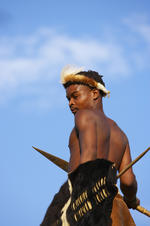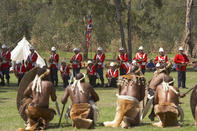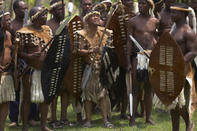Picking a Quarrel

The Anglo-Zulu wars started when the British high commissioner in South Africa, Sir Henry Bartle Frere, believed that the robust and economically independent Zulu kingdom was a hindrance to his plan of uniting all South African territories under the British flag. So he picked a quarrel with King Cetshwayo under the Ultimatum Tree on the south bank of the uThukela River, which cyclone Demoina subsequently uprooted in 1984.
In the late 19th century the British Empire was at the height of its power and the British Army was bringing law and order across the globe from Afghanistan to Zululand.
A few pesky American ex-colonials aside, no one could withstand the might of the great red army. Certainly not the zulu people, armed only with cowhide shields and short stabbing spears.
What the arrogant British army marching behind Lord Chelmsford had neglected to consider, when they invaded Zululand in 1879, was the Zulu people’s proud and fierce military tradition, instilled by successive kings.
The Brits eventually won the war, but the empire came away with a decidedly bloodied nose.
Attacking Zululand

It was 22 January 1879 when three columns of mainly mounted British soldiers breezed into Zululand for what they thought would be the easy task of subjugating King Cetshwayo.
On the 22nd they made camp on the slopes of a prominent hill, the name of which has since been immortalised. Early the next day Lord Chelmsford set off with about half his force to assist Major Dartnell, who was believed to have made contact with the Zulu forces.
The camp was left with about 2 000 British regulars and about half again colonial units. During their midday lunch, a scouting party chanced upon the entire Zulu army hiding in a wooded valley about 6 km from the camp. The Zulus immediately attacked in their buffalo-horn encircling formation and by 14:00 the battle was over, save for a few isolated incidents.
It was the most humiliating defeat ever dealt the British Empire by a non-European force. It's been estimated that on the slopes of Isandlwana hill that day around 1 330 men on the British side (910 white and 470 black) and between 1 500 and 3000 Zulus died - many of them from drinking medicines they plundered.
Ntombi Drift

On 12 March 1879 treacherous Swazi chief Mbilini took advantage of the war mayhem in the area to ambush a British supply column under the command of Captain Moriarty. It was probably to curry favour with his Zulu neighbours as much as to take a side-swipe at the invaders and come away with some war spoils.
Moriarty was headed for Khambula to replenish the supplies of Colonel Sir Evelyn Wood, who was soon to do battle there, but the flooded Ntombi River forced the poorly-protected supply column to halt a few days. Mbilini's force easily overpowered the laager, killing a large number of Brits and making off with as much treasure as they could carry.
Nkandla Forest
Nkandla is one of the most beautiful remaining tracts of mist-belt forest in KwaZulu-Natal, harbouring, among many rare organisms, the Karkloof blue butterfly. The graves of Zulu kings Malandela and Cetshwayo are to be found at Nkandla, so it is central to the Zulu heritage.
In 1905 the Natal government imposed a tax on the 'natives', which Chief Bhambatha refused to collect or pay. A warrant for his arrest was issued and when an armed force came to apprehend him, he and his people fled into the forest. Artillery was brought in and the forest was shelled in an attempt to force a surrender.
On 10 June 1906 the two sides finally clashed at the Battle of Mome Gorge. Nearly 600 'rebels' were killed, including Bhambatha himself, who was decapitated and his head taken to Nkandla town supposedly for identification, but more likely as a warning to the people. The incident is often referred to as the Bhambatha Rebellion and is cited as a forerunner of the 20th-century freedom struggle. Today, a visit to this forest, as well as nearby Ngoye and Dlinza, is a sensory delight.